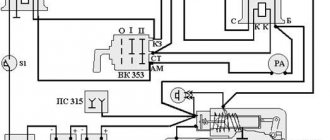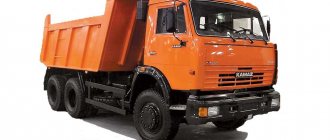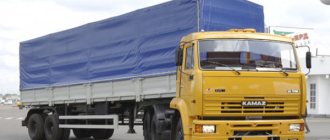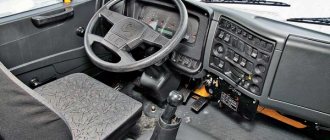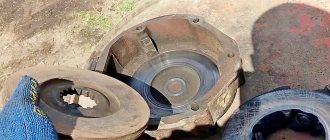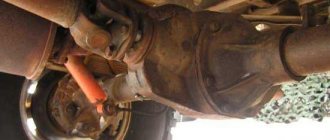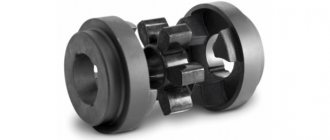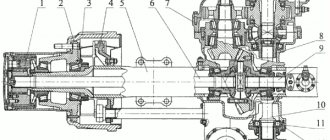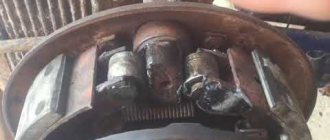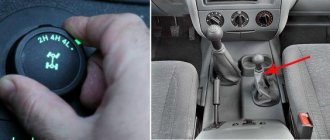The MOD is installed on the gearbox of the KAMAZ middle axle and is one of the units that receives a fairly large load, which often disables it. The center differential is one of the most fragile components of the KAMAZ vehicle transmission; it is assembled as part of the middle axle gearbox.
The task that the center differential performs is to improve the vehicle's handling.
How does this happen? If the MOD is turned off, rotation goes only to the rear axle, this allows you to save the resource of the middle axle gearbox. The load on the bridge is reduced, and accordingly the car becomes more economical.
If the MOD is turned on, it is blocked and the gearbox shafts of the drive axles are connected, which increases the vehicle's cross-country ability. This can help in difficult road conditions, such as ice.
Also, the ability to disable the middle axle using the MOD saves fuel. In rare cases, the middle axle gearbox may not be equipped with a MOD; for example, on all-wheel drive vehicles, reducing cross-country ability may not be necessary, so often there is no center differential.
Since the MOD completely absorbs all the torque and all the power of the engine, it is subject to quite serious loads. Very often the MOD fails due to the main driveshaft of the car, which is attached to it. For one reason or another, the main driveshaft may be unbalanced. And this imbalance places a harmful load on the center differential.
Center differential malfunctions
One of the main reasons for MOD failure is oil starvation. The MOD is located at the top of the middle gearbox. Due to the low oil level in the axle, it may not receive enough lubrication. This leads to increased wear and failure of the main gears, up to the breaking of the MOD in half.
Some of the MOD malfunctions can be determined independently. One of the main signs of a malfunctioning MOD is a play that appears on the MOD flange. Oil leaks also indicate that you need to pay attention to the operation of the MOD. If the MOD overheats without oil, the paint on it will burn.
The differential must be locked when there is a difference in the traction forces between the wheels between which it is installed. The lock should be turned on immediately before overcoming difficult sections of the route (sticky soil, obstacles, slippery muddy roads).
Attention! Turn the lock on and off with the clutch disengaged and only after the vehicle has come to a complete stop. When one of the wheels slips, the lock cannot be engaged. In this case, turn on the lock only after stopping the car. With the differential locked, you need to move straight at a speed of no more than 10 km/h without stopping, avoiding wheel slipping. The lock must be disengaged immediately when driving onto a hard, dry road, since driving with the lock engaged can lead to damage to the final drive parts. Driving with the lock engaged on hard roads is strictly prohibited!
Signs of malfunctioning KAMAZ transfer case
The transfer case, like most parts in the design of a truck, does not give itself away until something breaks in it. In 85% of cases, breakdowns are associated with current wear and tear, and only in 15% with mechanical breakdowns caused by external factors or improper operation of the unit. In order to pay attention to malfunctions in time, you need to carefully monitor the following factors:
presence of extraneous noise while the vehicle is moving;
random switching off of gears;
wedges or jamming of the lever;
damage to the transfer case.
The problems listed above appear not only on KAMAZ trucks. Trucks of other brands equipped with a transfer case exhibit the same problems.
Cross-axle differential lock control
To turn on the cross-axle differential lock:
1. Turn on the center differential lock of the middle axle (if there is a center differential). 2. Press the cross-axle differential lock switch at the bottom. Two warning lamps light up and an intermittent beep sounds.
To turn off the cross-axle differential lock, press the cross-axle differential lock switch at the top. The warning lights go out. If necessary, turn off the center differential lock, the sound signal turns off.
Of the four wheels of the cart, three spin when all the locks are ON. Accordingly, the MOD works by itself, and it turned on! Because the MKB is powered after the MOD. I turned on the faucet to ON MOD, air flowed to the electric valve, from which the ICD was ON. Then you click the key on the ICD. I went through all this with my fingers when the body was removed, and unscrewed the ICD hoses on the stockings to make sure the system was working! I was getting ready to say so. The question was whether the ON moment of the ICD is regulated directly on the stocking. Murat said that, yes, we need to take off the woman’s stocking and look. Until I got around to it, and then I realized what to watch.
The only thing is, I think you need to learn the subtleties, otherwise I’ll screw it up and the ICD won’t turn off on this bridge! It's the adjustment process itself that interests me. You need to make sure that everything is turned correctly! Or stupidly twist one or two mods and that’s it.
Of the four wheels of the cart, three spin when all the locks are ON. Accordingly, the MOD works by itself, and it turned on! Because the MKB is powered after the MOD. I turned on the faucet to ON MOD, air flowed to the electric valve, from which the ICD was ON. Then you click the key on the ICD. I went through all this with my fingers when the body was removed, and unscrewed the ICD hoses on the stockings to make sure the system was working! I was getting ready to say so. The question was whether the ON moment of the ICD is regulated directly on the stocking. Murat said that, yes, we need to take off the woman’s stocking and look. Until I got around to it, and then I realized what to watch.
The only thing is, I think you need to learn the subtleties, otherwise I’ll screw it up and the ICD won’t turn off on this bridge! It's the adjustment process itself that interests me. You need to make sure that everything is turned correctly! Or stupidly twist one or two mods and that’s it.
Of the four wheels of the cart, three spin when all the locks are ON. Accordingly, the MOD works by itself, and it turned on! Because the MKB is powered after the MOD. I turned on the faucet to ON MOD, air flowed to the electric valve, from which the ICD was ON. Then you click the key on the ICD. I went through all this with my fingers when the body was removed, and unscrewed the ICD hoses on the stockings to make sure the system was working! I was getting ready to say so. The question was whether the ON moment of the ICD is regulated directly on the stocking. Murat said that, yes, we need to take off the woman’s stocking and look. Until I got around to it, and then I realized what to watch.
The only thing is, I think you need to learn the subtleties, otherwise I’ll screw it up and the ICD won’t turn off on this bridge! It's the adjustment process itself that interests me. You need to make sure that everything is turned correctly! Or stupidly twist one or two mods and that’s it.
Catch Kolya adjusting the ICD. Adjustment of the cross-axle differential locking mechanism must be done in the following order: - remove the main gear; -remove the cover of the locking mechanism; — remove the piston with the rod; — set the locking clutch to a position in which the distance from plane A of the clutch ring gear to the axis of the hole d = 338 + 0.215 mm in the axle housing is 170 mm; — measure dimension B from the surface of the fork pin to the reference plane of the crankcase flange; — assemble the piston with the rod in size B+7 mm, lock it with a nut and install it in the axle housing, tighten the bolts securing the cover and diaphragm evenly, and the tightening force should ensure tightness, without excessive compression of the sides of the diaphragm; — check the stroke of the locking clutch when supplying air to the diaphragm, which should be 14 mm. Cross-axle differential locking mechanism 1 - locking fork; 2 — axle housing support flange; 3 - sealing ring; 4 - diaphragm; 5 - piston; 6 - cover; 7 - switch; 8 — adjusting nut; 9 — rod of the locking mechanism; 10 - axle shaft; 11 - spring; 12 — rod; 13 - clamp; 14 — locking clutch; 15 — differential cup clutch
Option 2 - remove the cover of the locking mechanism; — remove piston 5 with rod 8; — on rod 8, unscrew the nut 7 and change the existing length A of the piston with the rod to a value equal to 90 mm. Insert the piston with the rod into the support flange 2 of the axle housing so that the end surface of the rod comes into contact with the elements of the locking fork 1; — install the control bolt 3 in the special device 4, so that the end surface of the bolt is in the same plane with the inner plane of the device (flush); — install a special device 4 with a control bolt 3 on the support flange 2, and tighten it on 2 opposite bolts 6; — measure size X1; — tighten the control bolt 3 until the piston 5 stops. In this case, it is necessary to create conditions so that when the control bolt 3 is tightened, the differential, turning relative to the axle shafts, is locked; — measure distance X2. If the difference between sizes X1 and X2 is less than 11 mm, then change size A to a value equal to: B = 11 - (X1 - X2), mm; — lock piston 5 with nut 7 on rod 8; — install the piston with the rod into the support flange 2 of the axle housing; — tighten the bolts securing the cover and diaphragm evenly. In this case, the tightening force should ensure tightness without excessive compression of the sides of the diaphragm; — check the travel of the locking clutch when supplying air to the diaphragm.
Good day. The essence of the problem is this...KAMAZ 65117, the locking does not turn on. But what happened was that the unit's turn-on lamp on the dashboard came on when the lock was turned off. then it would go out, then it would light up... then it was constantly on fire. as a result, the front burnt out for blocking, changed it and again such nonsense... I went to look, took the chip off the frog for the center blocking, the power doesn’t reach there, shorty... I took the chips off the solenoid valves, everything goes there fine, I put it on the valves, the pre is on. Maybe it's the valves themselves? shorted inside?! because the interaxle one worked, but the interdifferential one didn’t work... there are two valves, as well as two locks. Maybe someone has encountered them simply, I will be glad to any advice, otherwise winter is approaching, blocks are needed)
These are the valves and frogs on it.
Comments 28
I looked at the diagram. If your front wheel was knocked out by the center lock, then your feet should have stopped burning. Did this happen?
nope, my feet are burning. there before only blocking and goes. Well, and to the power take-off, if there is one.
I have a diagram for my four wheel drive. In it, the stop relay and the interlock pneumatic valve hang on one before. Maybe on the shaft itself it’s different - I HZ. But still, check to see if the red wire from the control lamp block to the pneumatic valve on the piglet is breaking through to ground.
Well, I have an onboard one, I checked the frame, everything seems to be normal. I'll try changing the valve, maybe it will help. All that remains is to wait for spare parts from the supplier.
Based on your recording, it’s difficult to understand exactly when you turn it on the premise burns out - this time. Second, your mistake is that you think that there should be a plus on the center frog. He gets there, but through the spiral of the control light. And if this wire rubs against the frame to ground, then there is no threat except that the light bulb will be constantly on, since when the frog is triggered, it is this wire that shorts to ground. Try an experiment. Connect ground to the red wire of the center frog. No pres will burn out. The light on the panel will just light up. As for the cross-axle one: That’s it, if the blue wire from the key to the pneumatic valve has a short to ground, the fuse will burn out. And if the winding in the pneumatic valve burns out, then it is not difficult to check. Disconnect the wires from it and call to see if both of its terminals are shorted to the body or if there is a simple break.
ok, tomorrow or the day after tomorrow I’ll start looking into it. Tomorrow it's easy intercity.
kamazovodik
Well, I have an onboard one, I checked the frame, everything seems to be normal. I'll try changing the valve, maybe it will help. All that remains is to wait for spare parts from the supplier.
KamAZ-43118: technical characteristics and reviews
The KamAZ-4310, 43118 car is reliable and proven over long kilometers of Russian roads. It is believed that this is a car with increased cross-country ability, produced at the Kama Automobile Plant since the beginning of 1981. At first, these cars were supposed to be used for the needs of the Secular Army, but then they were firmly entrenched in the national economy. Now they are confidently winning competitions, proving the indisputable advantage of our cars.
Device
Moscow designers also took part in the creation of the KamAZ car. At the time of the creation of the car, an advanced principle for the interaction of drive axles was developed and implemented. This refers to a permanent drive, which has four cardan shafts.
At the same time, the transmission is equipped with a center differential, which is supported by electric and pneumatic locking. There are several modifications that have some differences, but they are not significant. The KAMAZ 4310, 43118 vehicle is equipped with a KAMAZ-740.10 engine, which has a power of 210 -220 hp.
The basic version of the KamAZ 4310 vehicle is characterized by a shorter platform with a voluminous awning and a tailgate that folds down. The body has a row of seats for 30 people, which can be transformed, that is, they are folding. Years of production: 1983-1990.
KamAZ-43118 has an enlarged platform, which has a significantly higher load capacity. This modification of the KamAZ car began to be produced in 1996.
One of the important parts of the car is the gearbox, namely the KamAZ transfer case; it disperses torque if the road is bad, and it is distributed between the axle of the front of the car and the rear of the truck. What is the purpose of the transfer case?
Box device. The main components are the following:
- Carter;
- Main or drive shaft;
- Intermediate or secondary shaft;
- Shaft located on the front axle;
- Shaft for driving axles at the rear of the car;
- Shaft intended for power take-off;
- Center differential;
- Central control drive;
- The gear is responsible for overdrive.
Transfer case KamAZ 4310
KAMAZ 4310, 43118 are equipped with a reversing gear, usually two-stage, the differential on it is usually lockable and has an electro-pneumatic drive. In first gear the number is set to 1.692, in second – 0.917. The fastening of the box is usual, on rubber pads and brackets and is fixed on the frame spar, as well as on the cross members located between the two.
The crankcase on the KAMAZ 4310.43118 motor vehicle is made as a cast structure on which a vertical connector is located. A power take-off box is installed on the upper section of the crankcase using a hatch. This is the structure of the box.
The crankcase is closed with a lid; the manufacturer provides for oil filling through this connector, which is closed with a plug. The driver can easily check the level of consumed oil; this can be done through the lower hole, which is also equipped with a magnetic plug. The crankcase is protected on top by a lid, that is, the crankcase hatch, and it is intended for power take-off.
The operation of the drive shaft involves two types of bearings: ball bearings (1 piece) and cylindrical roller bearings (2 pieces). The bearings located in front have a seal, and the rear bearing is located inside the crankcase, in a special compartment.
There is a gear on the shaft; it is not only a drive gear, but it is also pressed in, and the gear responsible for power take-off is already welded onto the hub.
The intermediate shaft moves thanks to bearings, both roller and cylindrical, which are protected by covers. The intermediate gear, as well as the first gear, are fixed to the shaft and move differently on it. From the oil sump, which is located above the intermediate shaft, oil flows onto the gear rollers by gravity. Both gears have teeth embedded in them, and it is on them that the clutch is attached, which is responsible for the first gear, and specifically for engaging it.
How does a center differential work? As you know, the wheels of the front axle and the wheels on the trolley spin differently, especially if the movement occurs on an unpaved road, on a country road, or equipped only with crushed stone backing. The differential distributes the torque between them in a percentage ratio of 1:2; it is installed at the very bottom of the crankcase on two bearings: roller and cylindrical. Also provided:
- Main, drive gear;
- Rear clip, and front;
- Solar, as well as in a pair of epicyclic gears;
- Satellites.
Both cages are fixed on the drive gear, while the sun gear is located on the splines of the front axle shaft, and the epicyclic gear is paired with the bogie shaft. The satellites are mounted on bushings made of bronze, in the front differential race and support washer. Their task is to always be in conjunction with the gears, as mentioned above with the solar and epicyclic ones.
On the holder in front there are two roller bearings, and the gear responsible for second gear also rotates there. A gear coupling helps connect to the front cage. The coupling allows you to lock the differential, and on the front shaft of the axle drive there is a gear to drive the sensor, which reflects the readings of the speedometer, which is located on the crankcase.
Using the switch, which is located in the driver's cabin, you can control the gearbox (RK), the system is responsible for this action, which includes a switch, electric pneumatic valves, two pneumatic chambers and pneumatic actuators, and a sensor responsible for switching on.
Kamaz 4310 transfer case diagram
After turning on the switch, compressed air is not able to enter the pneumatic chambers, and therefore the diaphragms return to their original position. The torque between the shaft gears is transferred to the races and satellites. The gears, carried by the satellites, allow you to move along a good, damage-free road as a single unit. If the road becomes uneven, for example, off-road, the front axle and the bogie move differently, and then the epicycle with the sun gear rotates at different speeds, and the satellites rotate not only around the main axis, but also around their own axes.
Both gears can turn on at the same time, and to prevent this, a lock is supposed to prevent this from happening. If we take into account the differential lock, then when locked, the pneumatic chamber moves the clutch, which serves as a connecting element between the cage and the drive shaft on the front axle. This allows you to move on roads of different quality, both good and poor quality, as a single mechanism, the torque is proportionally distributed between the front axle and the bogie, as are the loads on them.
To eliminate the load on the transmission, the differential is constantly active, that is, unlocked. Only in a situation where you are driving on slippery roads should you use a lock, as this reduces the risk of wheel slipping and guarantees the safe movement of the vehicle.
Lubricating the RK is quite simple. It is enough to spray the oil, and about five liters of oil of a certain brand are poured into the crankcase.
If there are obvious signs of breakdown, then the RC must be replaced; this should be done in the following cases:
First of all, this is a characteristic knocking noise that occurs due to damage to the teeth on wheels equipped with such teeth, and if the bearing ceases to function due to wear.
Due to the fact that the teeth on the couplings, on the gears and on the gearboxes become unusable, the gears are switched off randomly. The shift fork foot may also be damaged.
If the parts that are in the gearbox are worn out, this leads to the fact that the gears are difficult to engage, the gear shift rods jam, and the differential locks. The power take-off on KAMAZ-4310, 43118 vehicles may also jam.
Possible damage to the RC, for example, chips, cracks. Failure of fastenings and other damage that can be considered mechanical.
